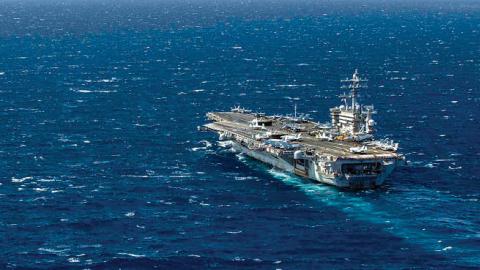President Biden’s cabinet confirmation hearings have in large measure been remarkably uneventful. The Senate has confirmed Avril Hanes as Director of Central Intelligence (84-10), Lloyd Austin as Secretary of Defense (93-2), and Antony Blinken as Secretary of State (facing the most resistance, 78-22). Along with Jake Sullivan as National Security Advisor, these four individuals will comprise Biden’s core foreign policy and defense team.
Subordinate positions in both the State and Defense Departments ordinarily take months to fill and the confirmation of Wendy Sherman and Kathleen Hicks respectively as deputy Secretary of State and deputy Secretary of Defense — however one regards their likely policy advice — advance the transition to a new administration. Of course, it will take several months to fully staff their departments. Moreover, learning the political landscape, even for seasoned insiders, can take weeks or months. Bureaucracy moves slowly. Crises demand attention. This pulls focus from long-term policymaking. The lost months of a transition can cripple policy coordination in a new administration’s second and third years.
This is particularly true of the service secretaries in the Defense Department. They are unique in Washington’s defense bureaucracy. Unlike those who focus exclusively on acquisition within the Service Departments and Defense Department, service secretaries also must consider long-term strategy. But they do so from a specific departmental perspective, unlike the policy-oriented undersecretaries throughout the Pentagon. Moreover, they work directly with their specific armed service, providing a critical civilian-military bridge that the Defense Department at large can lack. Although specific focus often leads to charges of parochialism, it has obvious benefits. The generalist will not understand, for example, the nuances of naval acquisition and force structure, and therefore can miss the strategic implications of an apparently banal funding allocation choice.
Considering the strategic dilemma that the U.S. faces today, the Secretary of the Navy has the greatest responsibility of the service secretaries. Global sea control undergirds all other elements of American strategy. Without it, the forward basing structure that the Army and Air Force rely upon to project power in Eurasia would be untenable. And naval force structure requires greater foresight than any other service because of the expense of building warships, the time required to design them, their life cycle costs, and their much greater time in service which easily exceeds that of most armored vehicles and aircraft.
Whomever Mr. Biden nominates to head the Navy Department will encounter a host of thorny strategic, force structure, and budgetary problems. Addressing these will highlight the gravity of the challenges the U.S. faces.
The incoming Secretary of the Navy will be required to lead the service through a critical transition. International political competition has returned. Responding to America’s rivals — namely China, Russia, Iran and North Korea — along with the prospect of international Islamic terrorism makes an agile force critical. Secretary Austin has indicated he will conduct a force posture review, a reasonable undertaking for any new administration. But if Austin’s conclusions conform with the apparent tenor of Mr. Biden’s foreign policy statements, Austin will likely return forward-deployed forces to Germany, emphasize cooperation with allies, and possibly trim budgets. Regardless of specific decisions, maintaining global sea control will remain critical to U.S. foreign policy, making the Navy’s global responsibility pivotal and its Indo-Pacific role critical to the security of the U.S. and its regional and global allies.
However, the prospect of great-power competition raises the specter of great-power war. In Asia, a great-power war will be a sea war. The Army and Air Force will play critical roles in a conflict with China. But victory or defeat depends on successful deterrence and ultimately upon the U.S. ability to control the Western Pacific’s island chains. This means either denying China its operational objectives or punishing Chinese aggression with an extended blockade. Or both.
The new Secretary of the Navy will benefit national security by outlining a service strategy where no articulated one exists today. The late Samuel Huntington called for a “strategic concept” — one that explains the Navy’s role in US foreign policy and guides the service’s acquisition programs, training procedures, deployments, and military exercises. This effort is long overdue. The Sea Services did release a maritime strategy in December 2020, “Advantage at Sea,” the first maritime strategic document the 2015 revision to the “Cooperative Strategy for 21st Century Seapower.” But throughout the Trump administration, the Secretary of Defense centralized acquisition and strategic planning, even preventing the Navy from conducting its own assessment of future aircraft carrier programs. If the Navy is to safeguard America’s interests, it must be able to state its strategic role and match acquisition and force structure to strategy. Hence the incoming Secretary of the Navy must make strategic thinking his top priority.
From these strategic challenges descend a series of force structure choices. Budgets will remain limited, and Washington bureaucracy competitive. Even if Mr. Biden eventually backs a budget increase, the traditionally equal distribution of budget resources among military services demands the most serious reconsideration. Neither tanks nor land-based air will deter, much less, defeat, China. A conflict in the West Pacific will only be prevented or won by seapower. Hence the Navy should receive the lion’s share of defense resources and will be forced to spend them wisely and design its force structure based on strategy that have been explained to Congress and the public.
Three choices are critical. First, will the Navy maintain its emphasis on large surface combatants designed to operate in a Carrier Strike Group, or will it resurrect its intermediate and small surface combatants, not common since the late Cold War? Second, what role will the Carrier Strike Group play in the Asia-Pacific? How will unmanned systems integrate into the air wing? How will the Navy integrate its fifth generation sensing platforms with its less sophisticated traditional fighter fleet? And how will it field long-range, perhaps hypersonic, missiles and glide vehicles? Third, how long will the Navy choose to keep its extant ships in service, particularly its guided missile destroyers and Nimitz-class carriers? Phasing them out early does help free up acquisition funds, but without a building program anchored to an articulated strategy, the Navy risks effective power projection abroad and domestic political support at home.
Finally, the future Secretary of the Navy will encounter a sea of bureaucratic troubles. The past four years allowed the land-based services, and particularly the Army, to exercise accelerating control over broader American strategy and defense policy. The Trump administration favored retired military officers, most of whom served in the Army. Two National Security Advisors were former army general officers. A third retired as a Major. The second of Trump’s two confirmed Secretaries of Defense, Mark Esper, was a retired Lieutenant Colonel. Acting Secretary Christopher Miller was an Army Colonel. Trump’s longest-serving Secretary of State was also a former Army officer. Even within the Navy Department, several undersecretaries — and even an acting secretary — were either former Army officers or were “double-hatted” in the Department of the Army.
Interservice democracy is an oft-forgotten keystone of American military effectiveness. Each service provides a unique strategic perspective, and should be encouraged to think creatively, pushing the other services to innovate in turn. By contrast, allowing a single service to monopolize strategic decision-making and centralizing Defense Department tasks in the Office of the Secretary of Defense undermines U.S. strategy. Will the appointment of an Army general officer as Secretary of Defense intensify interservice bureaucratic competition and become a bludgeon for the land services to be wielded against all others?
Responding to these challenges requires political and strategic skill. But the incoming Secretary of the Navy, regardless of specific policy choices, should take his case to Congress, rather than restricting himself to an internal bureaucratic competition that he will almost certainly lose. Unlike the post WWII days, Congress today possesses but a handful of senators and representatives who understand the connection between seapower and the nation’s future as a great power. An unexpected and profound international event will not translate into bipartisan Congressional expertise. The next Secretary of the Navy must provide it on his own.
Read in RealClear Policy


















